How ironic that Iga Swiatek ended her longest title drought on her worst surface at the most prestigious tournament. Even more surprising, one-time teen phenom Amanda Anisimova also revitalised her career by reaching her first Grand Slam final.
These feel-good stories highlighted a fortnight that started with an unprecedented 17 of 32 ladies’ singles seeds eliminated by the second round and ended with a different champion for the eighth straight time since Serena Williams in 2016.
Even though IBM Insights gave Swiatek — a five-time Major winner — a 69 per cent chance of winning, her 6-0, 6-0 demolition of Anisimova was yet another stunner in the ‘expect the unexpected’ world of women’s tennis. “I think almost everyone is in a state of shock at what transpired,” said BBC analyst John McEnroe. “She [Swiatek] played against someone who absolutely froze, which is really hard to watch. I feel terrible for her [Anisimova].”
It was the worst shellacking in a Major final since all-time great Steffi Graf ‘double-bageled’ Natalia Zvereva in a 31-minute yawner at the 1988 French Open and the most lopsided match at Wimbledon since 1911, when Dorothea Lambert Chambers shut out Dora Boothby 6-0, 6-0.
“It’s about first-strike tennis and who can handle the pressure better,” said ESPN analyst Mary Joe Fernandez before this forgettable, 57-minute final. Suffering from stage fright, Anisimova dropped eight of the first 10 points to fall behind 2-0 quickly. If the final had a critical juncture — at least for the tall (5’11”), hard-hitting American — it was the third game. Anisimova built a 40-15 lead and had four chances to hold serve. Alas, a Swiatek backhand winner, along with two unforced backhand errors and an unforced forehand error by Anisimova, squandered those chances before a double fault gave the game to Swiatek.
The champion completed the Saturday afternoon massacre on Centre Court with a backhand winner down the line. The demoralised runner-up didn’t even run for the ball. “Iga was hitting everything [well]. She played flawlessly,” said ESPN analyst and former superstar Chris Evert. Indeed, Swiatek had a staggering 55–24 advantage in total points won, as she smacked 29 winners against only 11 unforced errors.
Perfect storm: In a display of sheer dominance, Iga Swiatek dismantled Amanda Anisimova with a double bagel — 6-0, 6-0 — in the final.
| Photo Credit:
Clive Brunskill
Perfect storm: In a display of sheer dominance, Iga Swiatek dismantled Amanda Anisimova with a double bagel — 6-0, 6-0 — in the final.
| Photo Credit:
Clive Brunskill
The evolution of Swiatek is a tribute to her dedication and her closely knit team — the astute coaching of Wim Fissette (who previously guided Kim Clijsters, Victoria Azarenka, Simona Halep, Angelique Kerber, and Naomi Osaka), the support of her longtime sports psychologist Daria Abramowicz, fitness trainer Maciej Ryszczuk, and hitting partner Tomek Moczek. “I feel they believed in me more than I did,” Swiatek said during the trophy ceremony.
After the undisputed Queen of Clay — she won four Roland Garros crowns this decade — failed to capture a title on clay this spring, she added power to her serve, flattened her Western forehand a bit, and became more comfortable moving on slick grass. It paid off. She made her first final on grass at the tune-up tournament in Bad Homburg.
After notching a 6-2, 7-5 victory over Russian veteran Liudmila Samsonova to reach the semifinals, a career-best showing at The Championships, Swiatek said, “I feel like I’m doing a great job at just learning how to play on grass. [It’s the] first time I feel more comfortable. I feel like the process has some kind of logic.”
Her learning curve accelerated in the last two rounds. Against Belinda Bencic, a 66-1 long shot who missed Wimbledon last year while on maternity leave, Swiatek completely dominated from start to finish, racing to a 6-2, 6-0 victory. Using her powerful first serve that peaked at 8.9 on the Serve Quality rating to complement her terrific forehand, Swiatek has developed a formidable serve-plus-one, quick-strike weapon that proved especially effective on grass. Once vulnerable to power hitters like Elena Rybakina, Aryna Sabalenka, Clara Tauson, Linda Noskova, and Danielle Collins, the 5’9” Pole now has the firepower to combat them.
As for Anisimova’s abysmal performance (eight winners against 28 unforced errors), Evert provided a ready explanation. “Amanda had nothing left in the tank, emotionally and mentally. After every win, she fell and put her hands on her face. She was so happy. She wasn’t used to that.”
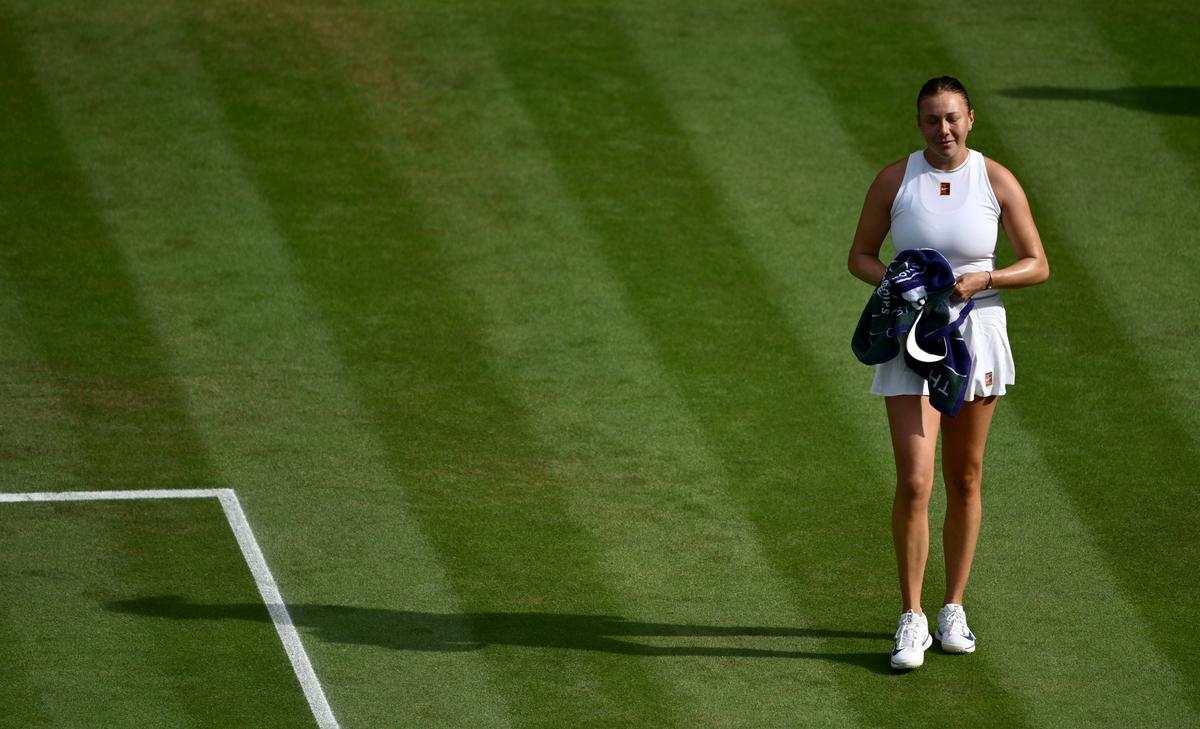
Solid comeback: After failing to qualify at Wimbledon a year ago, Amanda Anisimova racked up a 5–1 record against top-10 players this season. She ended up beating Aryna Sabalenka in the semifinal.
| Photo Credit:
Getty Images
Solid comeback: After failing to qualify at Wimbledon a year ago, Amanda Anisimova racked up a 5–1 record against top-10 players this season. She ended up beating Aryna Sabalenka in the semifinal.
| Photo Credit:
Getty Images
Although her dream run at the Big W ended in a nightmare final, Anisimova notched two excellent wins and a huge one to arrive there. Faced with a much tougher draw than Swiatek, Amanda outslugged No. 30 Noskova of Czechia, 6-2, 5-7, 6-4 in the fourth round and 2022 French Open finalist Anastasia Pavlyuchenkova, 6-1, 7-6(9), in the quarterfinals. She won the hard way against the 34-year-old Russian, not converting match points at 5-4 in the second set and then escaping set points at 6-3 in the tiebreak. “Amanda could have lost her cool, but she didn’t,” said Evert. Afterwards, the proud victor had her little nephew, soon-to-be-four Jackson, in hand during the on-court interview.
Amazingly, none of this year’s quarterfinalists in the women’s draw had reached the same stage at Wimbledon last year — and not one had ever made it to the final before.
That included, of course, Anisimova, who reached her second Grand Slam semifinal six years after making her first at the French Open as a 17-year-old rising star who led Ash Barty by a set and 3-0 before bowing out. Three months later, her life was rocked when her father and long-time first coach, Konstantin, died of a sudden heart attack at 52, an event she called “the worst thing that ever happened to me”.
Injuries and depression derailed her career, and in May 2023, she took an eight-month mental health break from the Tour. “A lot of people told me that you would never make it to the top again if you take so much time away from the game,” she recalled. “That was a little hard to digest because I did want to come back and still achieve a lot and win a Grand Slam one day.”
During her time away from the tournament grind, Amanda renewed friendships, painted, and took college courses. When she returned to competition in January 2024, she regained her love of the game. “It’s all about the process and enjoying every single day,” she said.
After failing to qualify at Wimbledon a year ago, Anisimova racked up a 5–1 record against top-10 players this season. Though she was a decided underdog against Sabalenka in the semifinals, the 23-year-old American boasted a 5–3 edge in their rivalry. “When you have five wins over a player, it doesn’t matter whether that player is [ranked] No. 1 or No. 50,” said ESPN analyst CoCo Vandeweghe. “It’s a big advantage.” In a battle of ‘Big Babe Tennis’, she had another advantage. She also had the fastest serve return of any player — male or female — in the tournament.
Sabalenka, however, was under immense pressure in this tournament, having lost three-set heartbreakers to Madison Keys in the Australian Open final and Coco Gauff in the French Open final. In her semifinal against Anisimova, during an 18-point game serving at 4-5, the Belarusian double-faulted to lose the opening set 6-4. Sabalenka, who hadn’t lost a match in straight sets at a Major since the 2020 US Open, fought back. Screaming, as she threw her body into every shot, she won the second set 6-4.
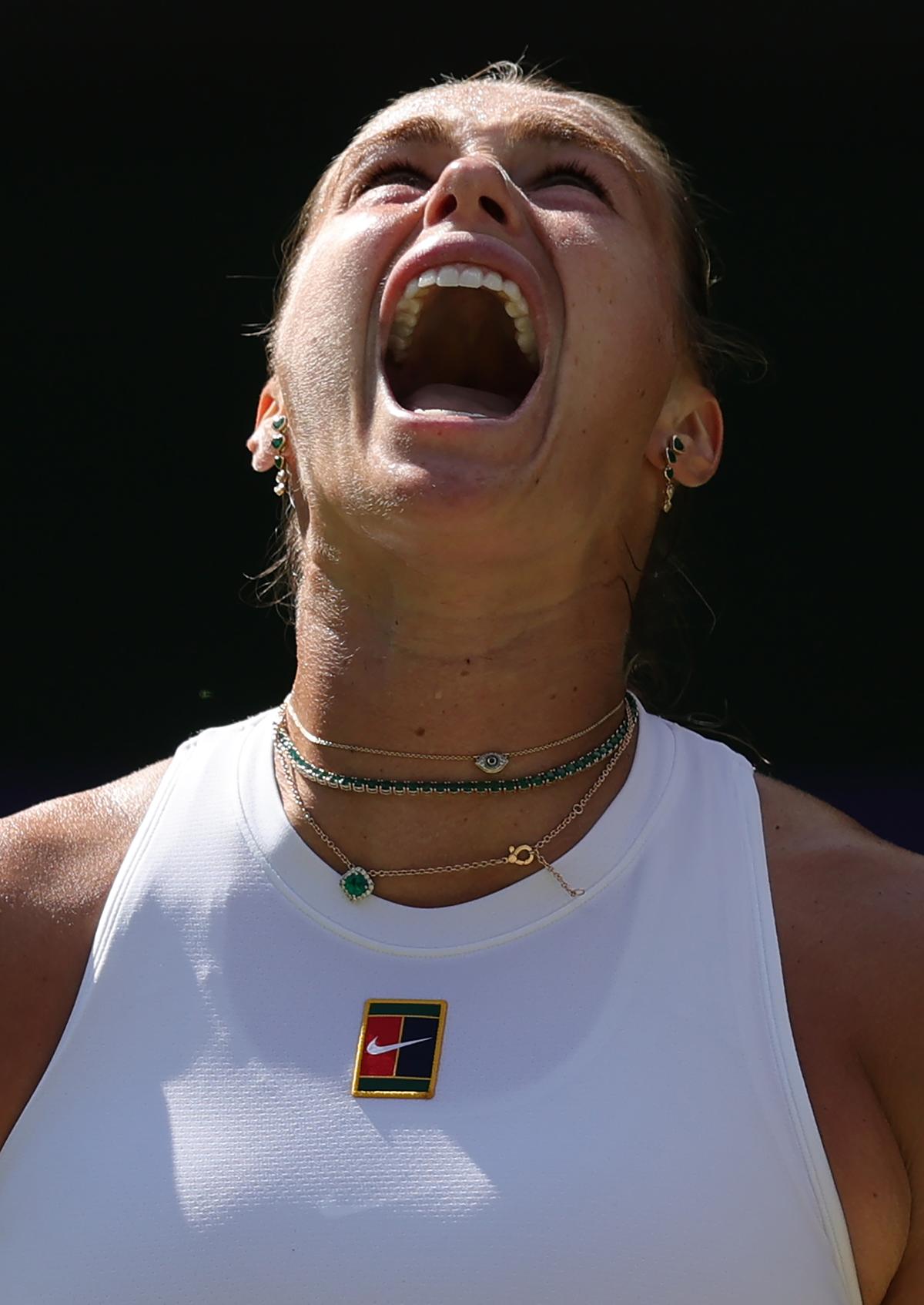
Heavy losses: After losing the finals in the Australian and French Opens this year, Sabalenka was under immense pressure.
| Photo Credit:
Getty Images
Heavy losses: After losing the finals in the Australian and French Opens this year, Sabalenka was under immense pressure.
| Photo Credit:
Getty Images
With Sabalenka serving at 4-5 in the deciding set, both had won 104 points. Anisimova earned three match points, leading love-40. Sabalenka staved off the first two. But Anisimova belted a bold forehand crosscourt winner to clinch the 6-4, 4-6, 6-4 triumph. “It was such a rollercoaster match,” Anisimova, ranked No. 189 a year ago, told ESPN. “I had to keep it together and go for it as much as I could.” Sabalenka, who converted only three of 14 break points, admitted, “I should have been a little more brave today.” However, she showed more grace in defeat than she did after losing to Gauff five weeks earlier. “She was the better player. Losing sucks. You feel like you want to die.”
Bencic, the singles gold medallist and doubles silver medallist at the Tokyo Olympics, edged 18th-seeded Ekaterina Alexandrova 7-6(4), 6-4 in the fourth round. Bencic, who won the junior title here in 2013, said, “I’m happy I’m here to live the dream.” She then upset 7th-seeded Mirra Andreeva 7-6(3), 7-6(2) to advance to her second Major semifinal.
In her Centre Court debut, the poised and precocious teenager Andreeva parlayed her potent 120 mph first serve and nifty drop shot for a notable 6-2, 6-3 win over No. 10 Emma Navarro. Afterwards, Andreeva told the spectators, “One of my dreams was to see Roger [Federer] and Mirka in real life, and when I saw them [at 4-1], I got really nervous. Mirka, you look pretty. I like your outfit.” The Federers smiled in appreciation. This graciousness prompted a comment from Evert. “What a personality, and she’s just 18 years old.”
Laura Siegemund, who had never advanced past the second round at Wimbledon, conjured the biggest upset against Australian Open champion and sixth-seeded Keys. Before The Championships, Keys said, ironically, “I’ve always loved playing on grass. It just makes sense for my game.” Not against undersized (5’6”), ageing (37), much lower-ranked (No. 104) Siegemund, though. The German veteran, known more for her doubles success, had never gone past the Wimbledon second round before. Nonetheless, Siegemund stunned Keys 6-3, 6-3.
During the second set of the fascinating duel between the power hitter and the clever counterpuncher, Pam Shriver, the astute ESPN analyst, said, “This is like Charlotte’s Web. Siegemund is spinning her web, and Keys can’t get out.” With a masterly array of drop shots, stinging and touch volleys, extremely low slices, occasional powerful groundstrokes, accurate lobs, and splendid defence, Siegemund disrupted and defused the power game of the discombobulated Keys, eliciting a torrent of forced and unforced errors.
It was a tactical masterpiece reminiscent of long shot Roberta Vinci’s shocking upset of Serena in the 2015 US Open semifinals. Siegemund almost pulled off an even bigger upset against Sabalenka when she led 4-3, 40-30 in the deciding set of the most intriguing quarterfinal. “Siegemund’s feel [touch shots] is off the charts. Sabalenka doesn’t know if she’ll drop shot, slice, or drive the ball,” said Tennis Channel analyst Tracy Austin. “She played a master class in tactical tennis.” But power ultimately overcame finesse, and Sabalenka prevailed 4-6, 6-2, 6-4. The often-volatile Belarusian said, “I’m really proud of the way I handled my emotions out there.”
For those who bemoan AI ball tracking, which replaced line judges on all Wimbledon courts — breaking a tradition going back to 1877 — rest assured, ‘the human element’ lives on. Players still display their emotions in a variety of ways, from smiles to scowls and even worse. More ladies were fined for Code of Conduct infractions than gentlemen this fortnight – 8-7.
During the trophy ceremony, Anisimova wept when she thanked her mother, who flew to England on the morning of the final. “My mom puts in more work than I have, honestly. I love you so much.”
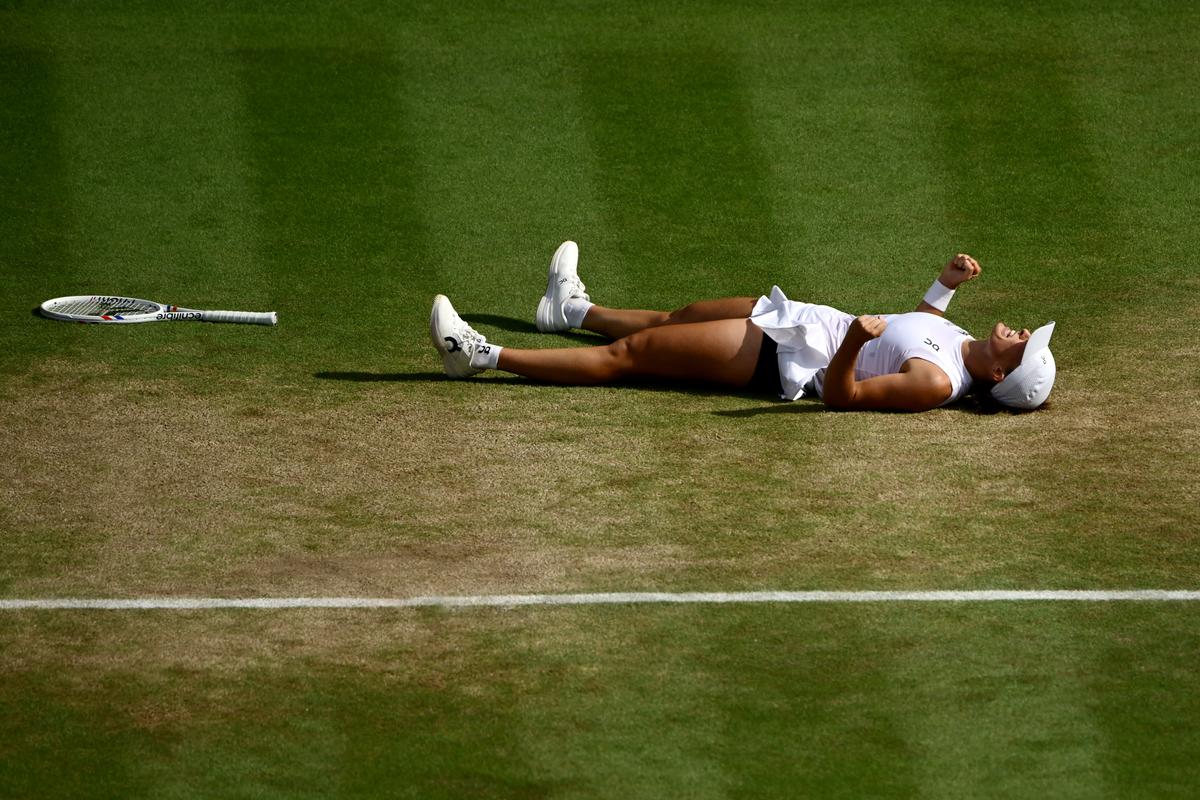
Growing legacy: Swiatek is now the eighth woman to capture Grand Slam singles titles on all three surfaces.
| Photo Credit:
Getty Images
Growing legacy: Swiatek is now the eighth woman to capture Grand Slam singles titles on all three surfaces.
| Photo Credit:
Getty Images
In the final, after a flawless performance, Swiatek fell on her back, a la Bjorn Borg, the stoic Swede who introduced that victory gesture when he won his first Wimbledon in 1976. The ecstatic Pole then paraded around Centre Court proudly holding aloft her trophy, the Venus Rosewater Dish. Swiatek is now the eighth woman to capture Grand Slam singles titles on all three surfaces, joining Evert, Martina Navratilova, Hana Mandlikova, Graf, Serena, Maria Sharapova, and Barty.
When Swiatek, still full of adrenaline, appeared on the All England Club balcony, she jumped for joy and pumped her fist a few times before soaking in the adulation of the cheering throng below her. “Iga, Iga,” they chanted, and loving it, she raised her arms, getting even more applause.
Swiatek’s celebrations culminated her ‘super surreal’ tour de force on the Wimbledon grass. “Honestly, I didn’t even dream [of this], because for me, it was just, like, way too far, you know?”
Jannik Sinner dethrones Carlos Alcaraz
Multiple questions intrigued sports fans during the fortnight as the clash of the titans became almost inevitable. Could any match surpass in mind-bending shots, fluctuating closeness, and non-stop entertainment than the French Open epic between Carlos Alcaraz and Jannik Sinner? Could Sinner, who lost their last five matches, turn their rivalry around, or would Alcaraz turn their duopoly into a monopoly? Could any of the other 126 players upset the new Big Two?
Their singular talents could be heard as well as seen by the cognoscenti. “The ball striking is what sets them apart. You can hear it,” said Darren Cahill, who coaches Sinner and analyses tennis on ESPN.
Sometimes it takes a bit of good fortune to win Grand Slam titles, even for The Great Ones. Grigor Dimitrov, touted as ‘Baby Fed’ early in his career for his athletic and stylistic resemblance to superstar Roger Federer, was playing the match of his life in the fourth round against Jannik Sinner.
The 34-year-old Bulgarian, seeded No. 19, built a stunning 6-3, 7-5, 2-2 lead by attacking 29 per cent of the time (compared to 23 per cent for Sinner), hitting 36 winners, and taking 20 of 29 net points. Serving at 40-love, Dimitrov grabbed his right pectoral muscle during a routine backhand volley. Then at 40-all, he writhed in pain. He laughed and then cried at his cruel fate.
For the fifth Major in a row, the snake-bitten Dimitrov was forced to retire with a serious injury. Sinner would lose only one other set during The Championships, to Carlos Alcaraz.
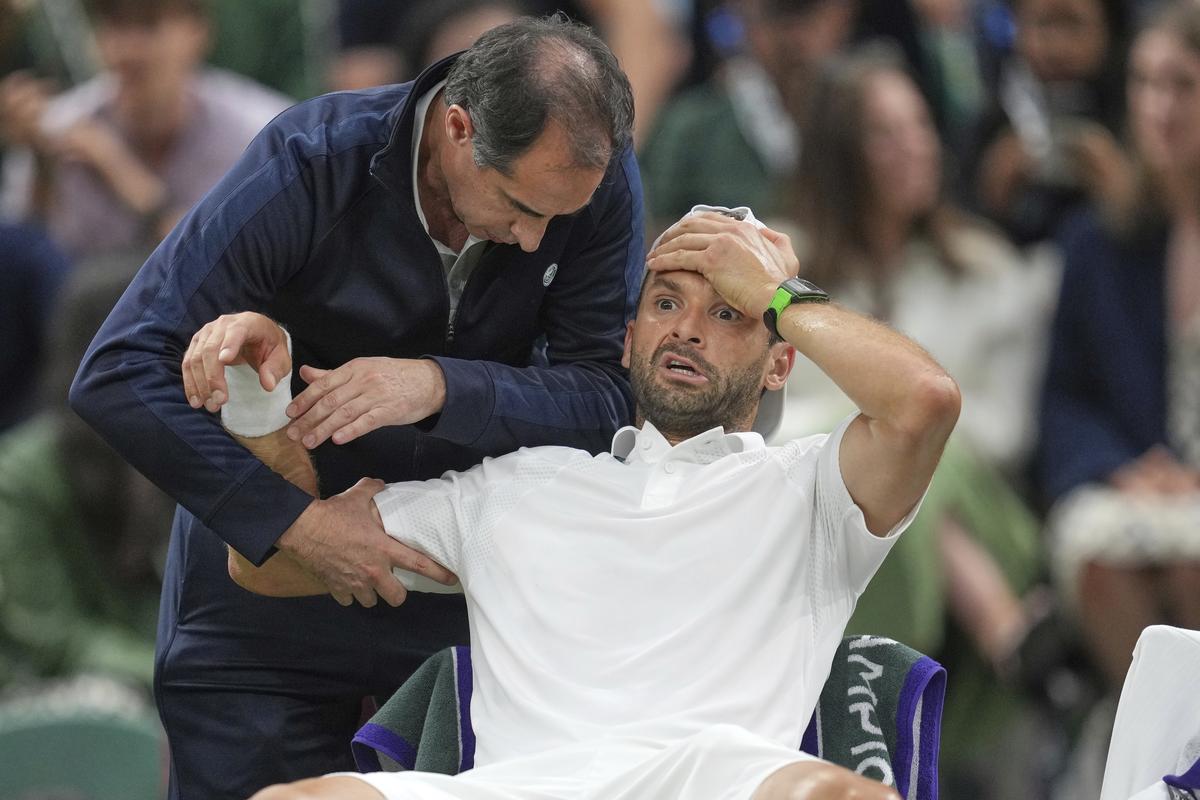
Run of bad luck: Grigor Dimitrov was two sets up against Jannik Sinner but was forced to retire due to injury.
| Photo Credit:
AP
Run of bad luck: Grigor Dimitrov was two sets up against Jannik Sinner but was forced to retire due to injury.
| Photo Credit:
AP
About his unusual victory, Sinner rightly said, “I don’t see this as a win.” In fact, it took a toll on him, too. Jannik fell in the first game and landed on his elbow. Although it caused him pain, an MRI showed it wasn’t serious. He wore a long protective sleeve covering taping on his serving arm against big-serving lefty Ben Shelton, the youngest American to reach the Wimbledon quarterfinals since Andy Roddick in 2004. Roddick, by the way, was the last American to win a Grand Slam singles title at the 2003 US Open. Would ‘Big Match Ben’ end the longest Slam drought in American tennis history?
Shelton, seeded No. 10, certainly couldn’t match Sinner’s power, precision, and consistency from the baseline. But his improved volley helped him win 43 of 58 net points in his 3-6, 6-1, 7-6(1), 7-5 victory over Lorenzo Sonego. Shelton is coached by his father, Bryan, who made the fourth round here 31 years ago. After losing his first match against Shelton at the 2023 Shanghai Masters, Sinner went on to win five straight matches, all in straight sets. This encounter would prove no different. Jannik looked sharp throughout, while Shelton was timid in the critical opening set tiebreak and succumbed 7-6(2), 6-4, 6-4.
Alcaraz, a happy warrior, started his title defence against the insouciant Fabio Fognini. The 38-year-old Italian had lost his last 10 Tour-level matches and was contesting his last Wimbledon in his farewell season. Returning Alcaraz’s serve phenomenally and casually hitting groundstrokes on the rise, he gave the heavy favourite fits. Alcaraz pulled out an entertaining 7-5, 6-7(5), 7-5, 2-6, 6-1 victory, but his 35 forehand and 62 total unforced errors were a bad omen.
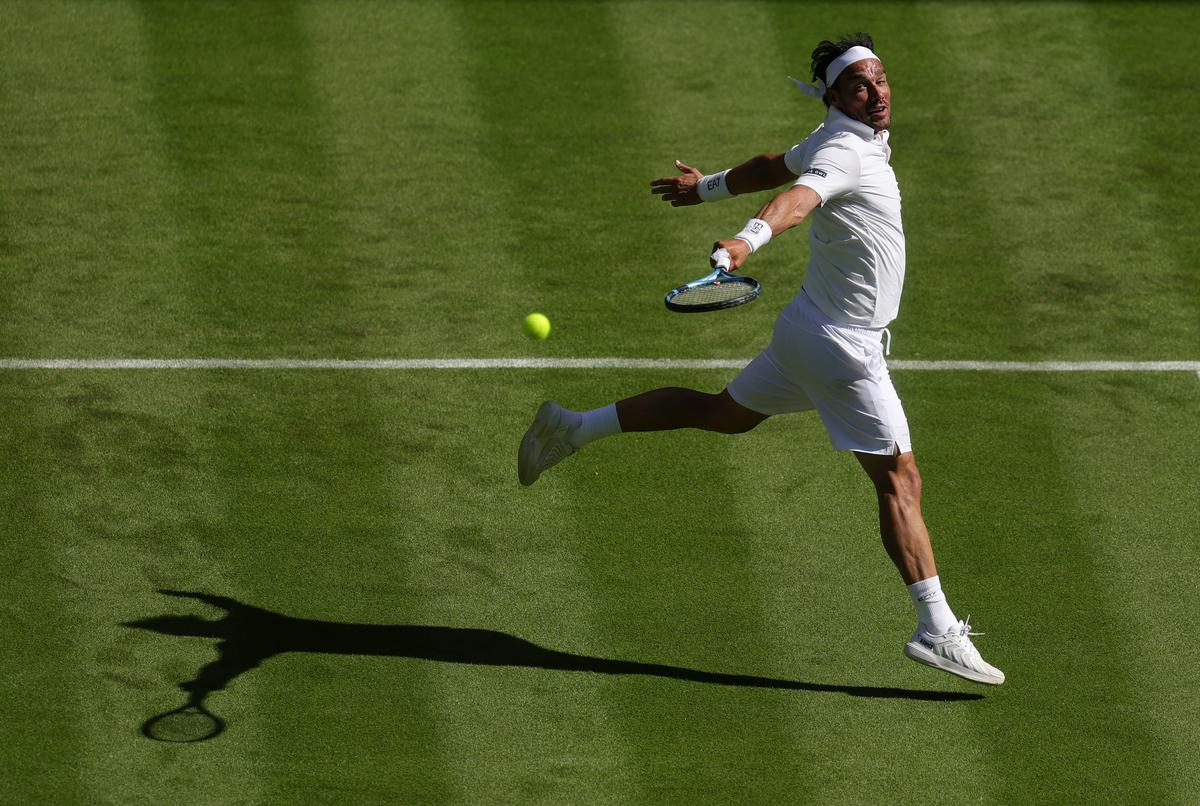
LONDON, ENGLAND – JUNE 30: Fabio Fognini gave Carlos Alcaraz a run for his money in the first round, taking the defending to champion to five sets. The Italian announced his retirement after this monumental loss.
| Photo Credit:
Getty Images
LONDON, ENGLAND – JUNE 30: Fabio Fognini gave Carlos Alcaraz a run for his money in the first round, taking the defending to champion to five sets. The Italian announced his retirement after this monumental loss.
| Photo Credit:
Getty Images
Alcaraz looked much sharper in his fourth-round 6-7(5), 6-3, 6-4, 6-4 win over 14th seed Andrey Rublev. The often-tempestuous 27-year-old Russian, who has been open about his mental health problems, stayed relatively calm and competed well, but his weak second serve and shaky volleying let him down. He won only 10 of 24 points at the net compared to 22 of 29 for Alcaraz. The knowledgeable, empathetic Centre Court spectators gave Rublev a standing ovation as he left the court.
Former world No. 9 and local favourite Cam Norrie offered little resistance to Alcaraz in their 6-2, 6-3, 6-3 quarterfinal. The indefatigable Norrie rode his bicycle to matches at The All England Club, but stamina was no factor in the one hour and 39 minutes on court. The Spanish maestro simply had too much firepower as he whacked 39 winners compared to 13 for his foe and more versatility, winning 22 of 31 at net.
IBM Watson made Sinner a 54 per cent favourite over Alcaraz in the Italian’s first Wimbledon final. Curiously, the day before, Watson had Alcaraz as a 54 per cent favourite.
The championship match featured mercurial athleticism versus methodical power. Alcaraz took the first set 6-4 on a spectacular set point. Two amazing Alcaraz defensive gets kept him in the heavy-hitting rally. Then, he yanked Sinner outside the alley with a wicked forehand crosscourt and finished with a flicked backhand crosscourt winner into the open court.
Before the second set, McEnroe pointed out, “Because Alcaraz can do anything, he tries lower-percentage shots sometimes in critical situations. Not every shot has to be highlight reel stuff.” So true!
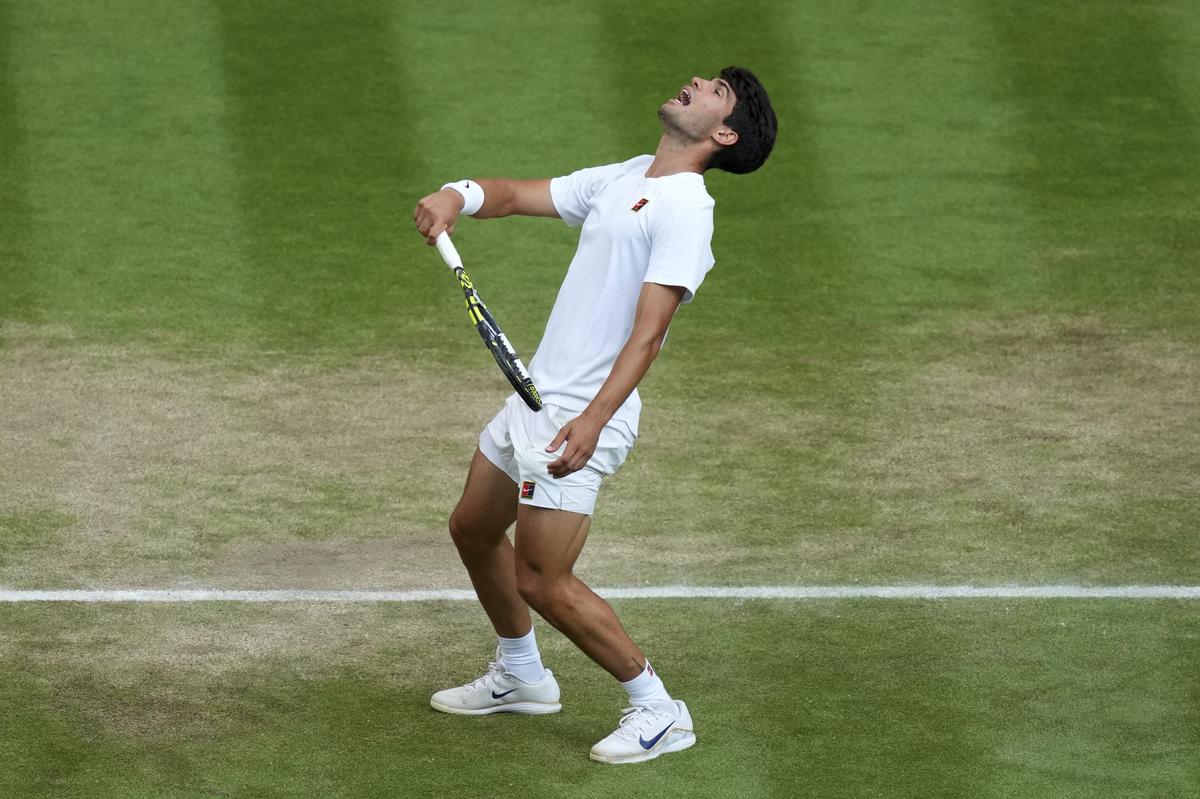
Heartbreak on Centre Court: Alcaraz produced some rollicking shots in the final, but they were not enough to beat Sinner.
| Photo Credit:
AP
Heartbreak on Centre Court: Alcaraz produced some rollicking shots in the final, but they were not enough to beat Sinner.
| Photo Credit:
AP
In the last three sets, Sinner increasingly anticipated and foiled Alcaraz’s drop shots and, more importantly, dictated baseline exchanges. When Sinner held serve for a 3-1 lead in the second set, Patrick McEnroe said, “We’re seeing more frustration from Alcaraz than we usually see and more outward emotion from Sinner than we’ve ever seen. They both know what’s at stake.”
The 6-4 second set also ended with a sensational point. Sinner trumped Alcaraz’s excellent crosscourt forehand with a ferocious crosscourt winner.
The Big Two elevated each other’s games, but Sinner was more consistent and took the third set, 6-4. When Sinner broke serve for 2-1 in the fourth set, Alcaraz looked confused and unsure of what to do. “Sometimes Alcaraz gets himself into trouble, but today it’s a case of his opponent hitting him into trouble,” said Patrick McEnroe.
During the changeover with Sinner leading 5-4 and about to serve for the championship, spectators rose to their feet and cheered. They wanted more — a fifth set like the two young superstars had in their memorable French Open final. But it was not to be. Sinner clinched the match with a 137-mph serve, his fastest of the match, that Alcaraz couldn’t return.
Game, set, and championship: 4-6, 6-4, 6-4, 6-4 for Sinner.
“It was a fantastic performance, a great bounce back from his French Open loss,” said Patrick McEnroe. “He was the one who came back from behind this time, even though it was only one set. It said a lot about his mentality. He was going to be positive.”
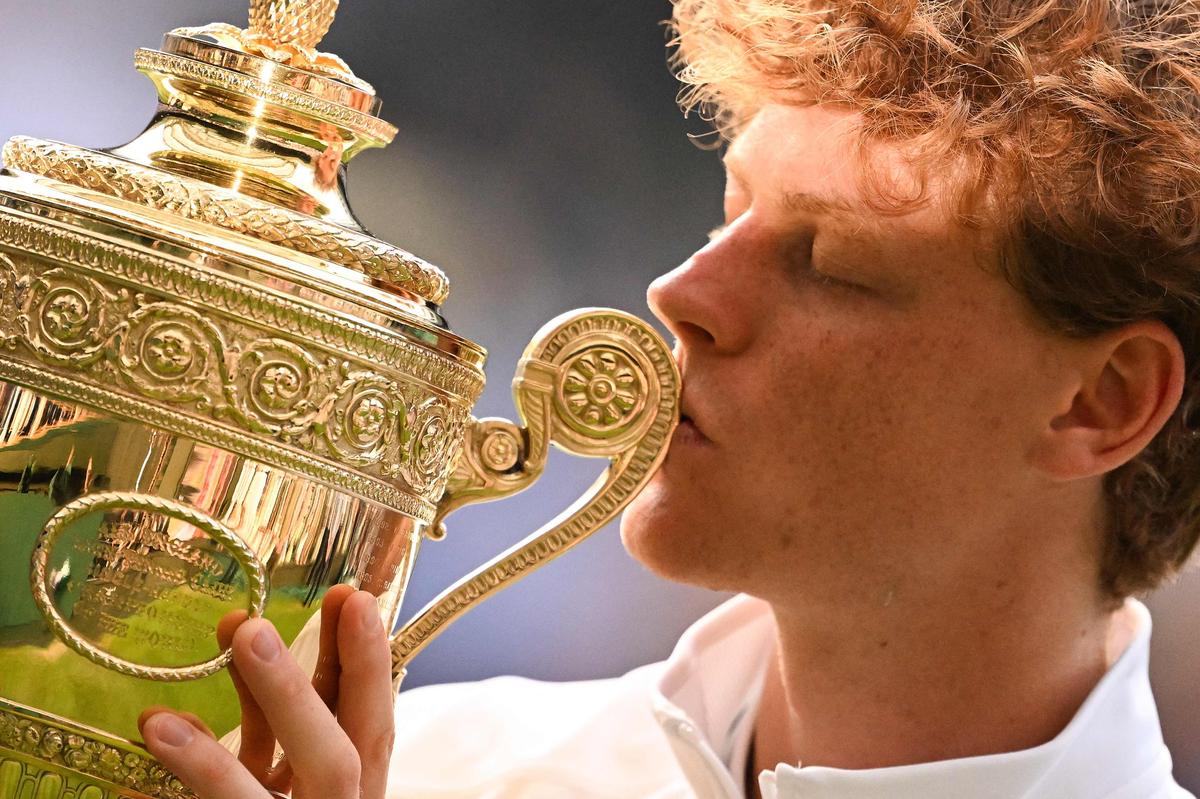
Leading a revolution: This was Sinner’s fourth Grand Slam title and his second of the year, following his win at the Australian Open.
| Photo Credit:
AFP
Leading a revolution: This was Sinner’s fourth Grand Slam title and his second of the year, following his win at the Australian Open.
| Photo Credit:
AFP
The most telling stat came from the new ‘In Attack’ category. Sinner had a 33 per cent rating compared to 20 per cent for Alcaraz.
“He was pushing me to the limit on every point,” said Alcaraz afterwards. “So mentally, sometimes, it’s really tough to maintain the good focus or the good level during the whole match when you see the opponent just playing such great tennis. At some points, I didn’t know what I had to do in the match, because from the baseline, I was feeling he was better than me, and I couldn’t do anything about it.”
On the other half of the draw, No. 5 seed Taylor Fritz enhanced his already impressive grass-court resume when he won June tune-up events at Stuttgart and Eastbourne. There was no rest for the weary, though: he faced a pair of 6’8” rocket servers in the opening rounds. With the roof closed and the heat stifling, Giovanni Mpetshi Perricard, a 21-year-old Frenchman, blasted serves over 150 mph, including a Wimbledon record 153. Fritz survived the onslaught, 6-7(6), 6-7(8), 6-4, 7-6(6), 6-4. However, 12 seeds — most notably No. 3 Alexander Zverev, No. 7 and 2024 semifinalist Lorenzo Musetti, No. 8 Holger Rune, and No. 9 Daniil Medvedev — were upset in the first round.
The carnage continued in the second round when 2014 US Open champion Marin Cilic ousted British hopeful and No. 4 Jack Draper, Norrie eliminated No. 12 Frances Tiafoe, and unheralded Austrian Sebastian Ofner stunned No. 13 Tommy Paul. Once again, Fritz survived, but barely. Gabriel Diallo, a wiry 23-year-old Canadian, banged 27 aces before Fritz came through 3-6, 6-3, 7-6(0), 4-6, 6-3.
Cilic’s 6-4, 6-3, 1-6, 6-4 victory over Draper, the best British man in the post-Andy Murray era, was the least surprising. As ESPN analyst James Blake pointed out, referring to the 6’6” Cilic’s ability to return Draper’s swerving lefty serve, “Cilic has a huge wingspan and one of the best backhands, so this was a great [style] match-up for him.”
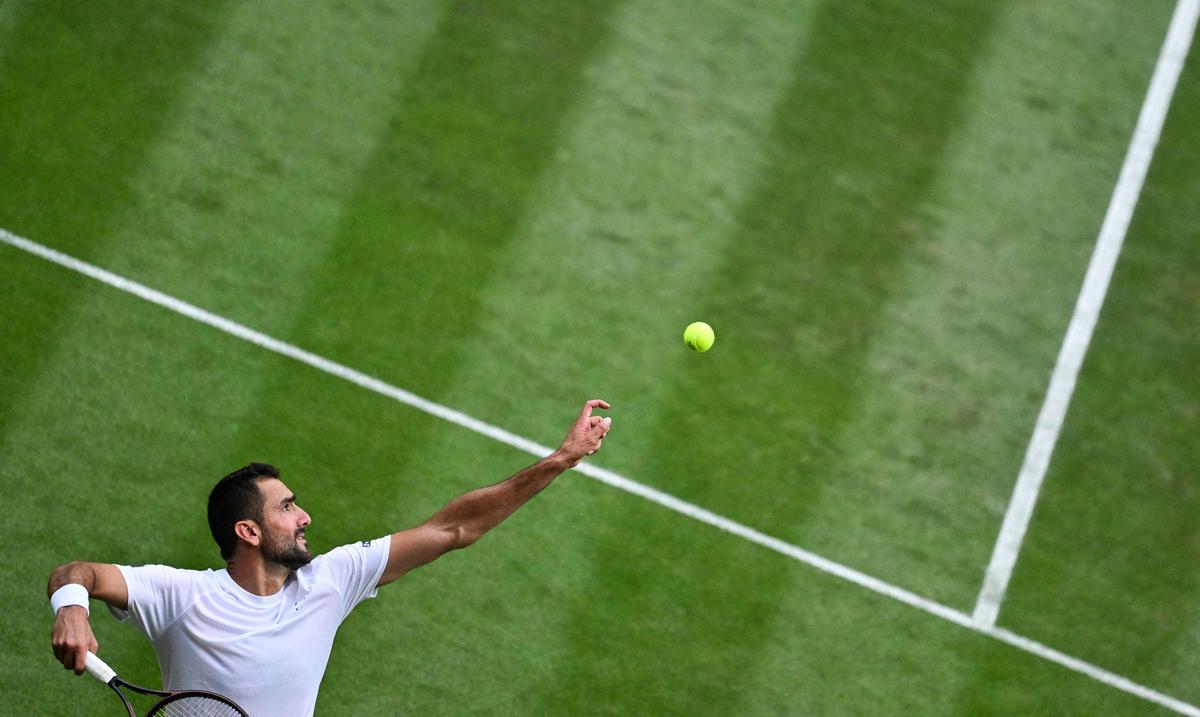
Old guard on the prowl: Veteran Marin Cilic best home favourite Jack Draper in four sets.
| Photo Credit:
AFP
Old guard on the prowl: Veteran Marin Cilic best home favourite Jack Draper in four sets.
| Photo Credit:
AFP
The heavy home country pressure, an intangible factor that Murray often talked about, clearly did Draper in, particularly on his normally powerful and consistent forehand, which he shanked and timidly sliced during crunch time.
Third-seeded Zverev’s 7-6(3), 6-7(8), 6-3, 6-7(5), 6-4 first-round loss to 72nd-ranked Arthur Rinderknech — his earliest elimination at a Major since 2019 — can be partly explained by his off-court anguish. Zverev confided, “It’s not a feeling on a tennis court, it’s just a life feeling in general. I never felt this way before. It’s difficult to find joy outside the tennis court at the moment. It’s something I’ve felt for the past few months. Again, I just feel generally very, very alone and very lonely.”
In Fritz’s semifinal against Alcaraz, the Spaniard was a 60 per cent favourite according to IBM Match Insights. “I would have given Alcaraz 80 per cent,” said McEnroe. Fritz was on a roll, winning 13 of his last 14 matches, but Alcaraz had easily defeated him at the 2023 Miami Masters and 2024 Laver Cup. The steadily improving 27-year-old American declared, “My goal is to win a Slam. If I don’t do that, it will probably always bother me.”
A nervous start cost Fritz an opening game service break and the first set. But he battled back in the 88° F heat to end Alcaraz’s streak of 42 service holds, when the defending champion played a terrible game, losing his serve at love and the second set, 7-5. Alcaraz regained his groove to take the third set, 6-3, and surged to a 4-1 lead in the fourth set tie-break. Stunningly, Fritz took the next five points to get two set points at 6-4. Alcaraz reversed the momentum one last time, grabbing the last four points — the most exciting one coming on a forehand passing shot for 5-6 — to win the tie-break and the match 6-4, 5-7, 6-3, 7-6(8).
“Fritz played a great match,” said ESPN analyst Patrick McEnroe. “And when he looked up at his [player’s] box, he wondered, what more can I do?” Not enough, as Alcaraz’s vast repertoire of shots and unparalleled athleticism—he won 31 of 41 net points—overcame Fritz’s potent serve and forehand.
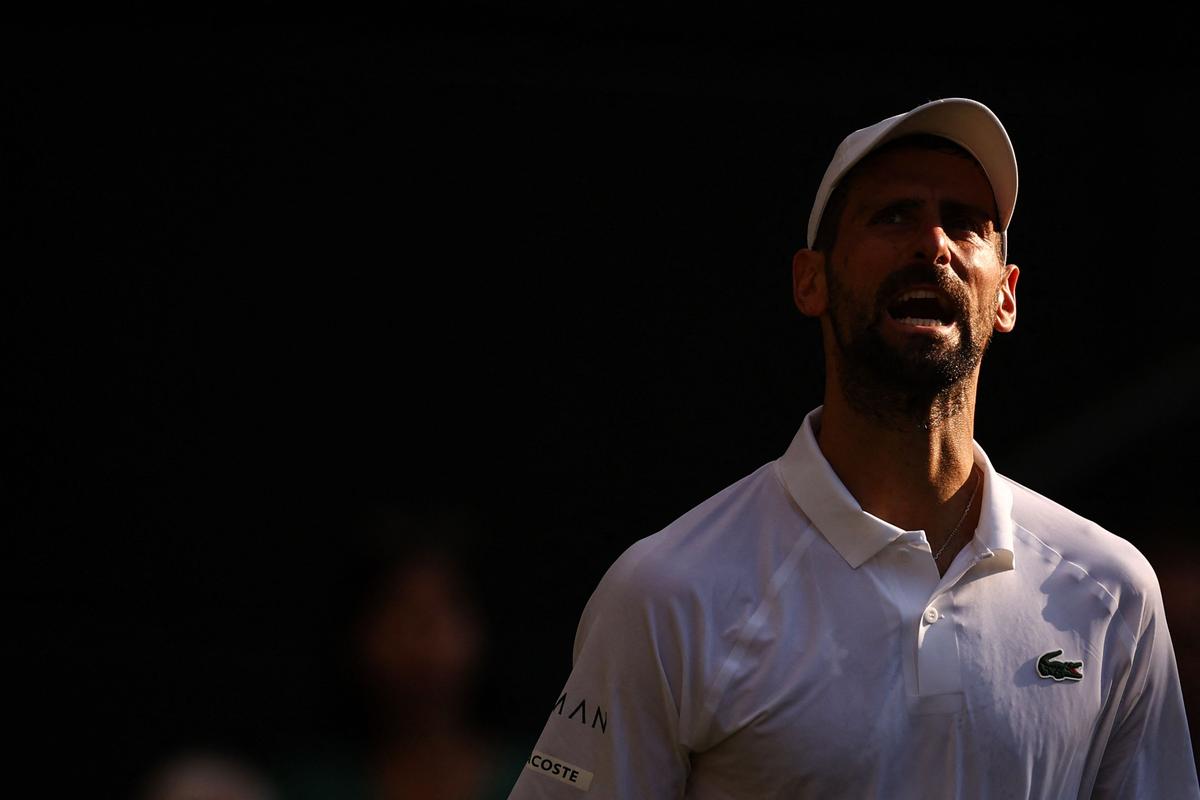
Sunset reckoning: Djokovic’s quest for an eighth Wimbledon title ended in the semifinal against Sinner. This was the first Wimbledon final since 2002 without Djokovic, Roger Federer, Rafael Nadal, or Andy Murray.
| Photo Credit:
AFP
Sunset reckoning: Djokovic’s quest for an eighth Wimbledon title ended in the semifinal against Sinner. This was the first Wimbledon final since 2002 without Djokovic, Roger Federer, Rafael Nadal, or Andy Murray.
| Photo Credit:
AFP
Novak Djokovic, the last of the legendary Big Three, viewed this Wimbledon as his last best chance to capture a 25th Grand Slam title. Already the undisputed GOAT, with two more Majors than second-place Rafael Nadal along with a gold medal at the 2024 Paris Olympics, Djokovic knew the odds were stacked against him. Like all the contenders, he’d most likely have to beat both Sinner and Alcaraz.
But first, Djokovic had to take care of business against 22nd-seeded Flavio Cobolli. The 23-year-old Italian, thrilled about the most memorable run of his young career, posted “Me versus my idol” on social media. The idol prevailed 6-7(6), 6-2, 7-5, 6-4, but it was a Pyrrhic victory. Sadly, on his second match point, Djokovic slipped and fell on the slick grass, injuring his hip. Grimacing in pain, he recovered enough to win the next two points. It was a small consolation that the triumph earned a 14th Wimbledon semifinal and 52nd Major semifinal, both of which are records. Afterwards, Djokovic said, “Great performance from him. He was playing on a really high level. I think what surprised me a lot is his serve. He was serving at a really fast pace and going for his shots. He’s such a talented and skilful player.”
Djokovic’s quest for an eighth Wimbledon title ended against Sinner, who Patrick McEnroe described as “a younger, more powerful version of Djokovic.” Sinner was also healthier, as his elbow had recovered, while Djokovic’s movement was compromised by his injured hip.
Aside from a short-lived 3-0 lead in the third set, neither his vast experience nor chants of “Nole! Nole” could save Djokovic during his decisive 6-3, 6-3, 6-4 defeat. When the GOAT didn’t run for a backhand crosscourt winner, Patrick said, “It’s painful for him, and it’s painful for us to watch.” Djokovic waved to the cheering crowd as he exited Centre Court. Later, he said he didn’t think this was his last Wimbledon.
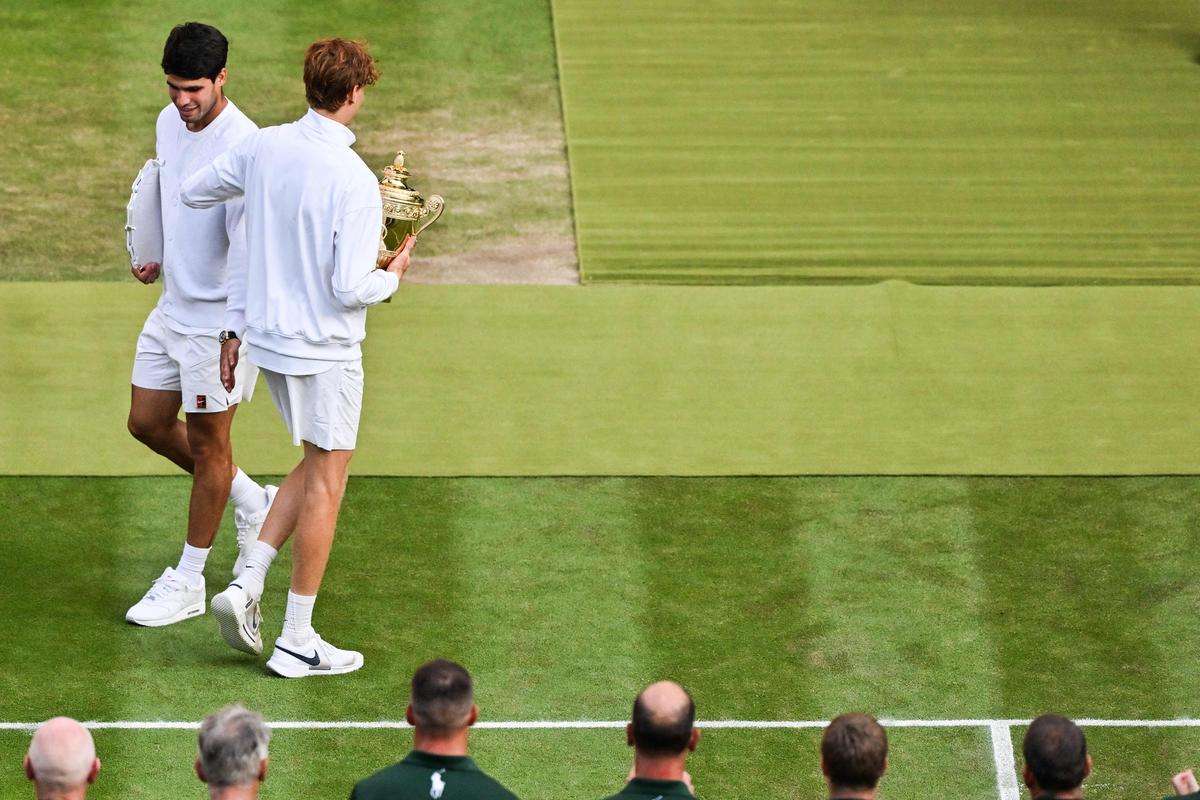
Sinner and Alcaraz have claimed the last seven Majors.
| Photo Credit:
AFP
Sinner and Alcaraz have claimed the last seven Majors.
| Photo Credit:
AFP
As for the Big Two, Sinner and Alcaraz have claimed the last seven Majors, relishing and thriving on their growing rivalry.
“Champions learn from… I’m not going to say their failures, but they learn from their losses,” said Alcaraz. “I knew he was going to learn from the French Open final and not make the same mistakes. That he was able to get over that so quickly and win here didn’t surprise me at all. The way he played today was really high, and he knew he was going to play like this. I know he’s a really nice player and a huge champion.”
Alcaraz continued, “I am really happy about having this rivalry with him. It’s great for us, and it’s great for tennis. Every time we play against each other, I think our level is really high. I don’t see any other players having the level we do when we face each other.”
Content Source: sportstar.thehindu.com

